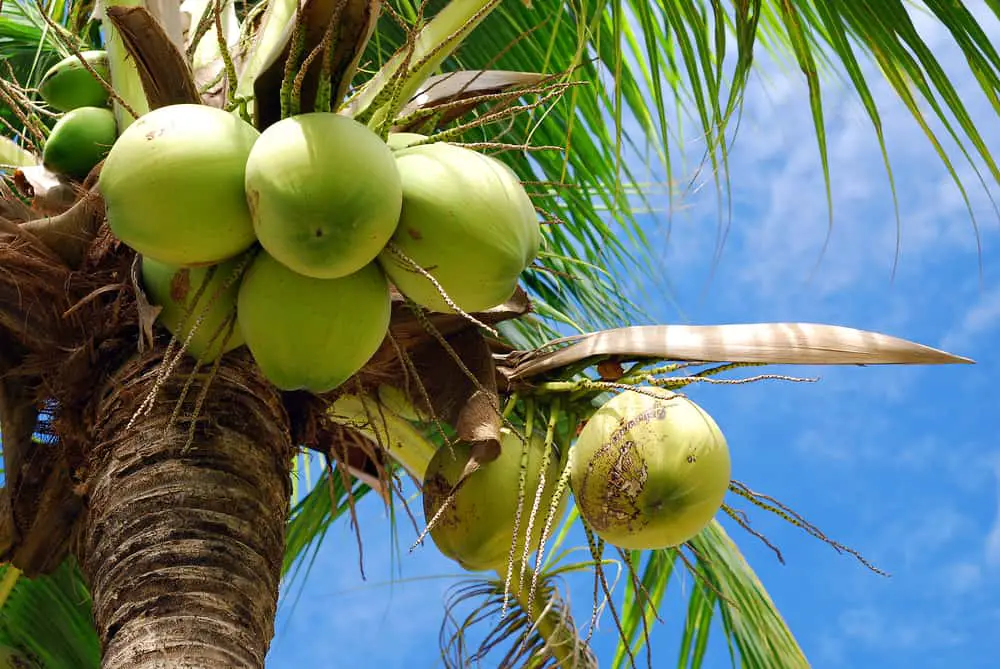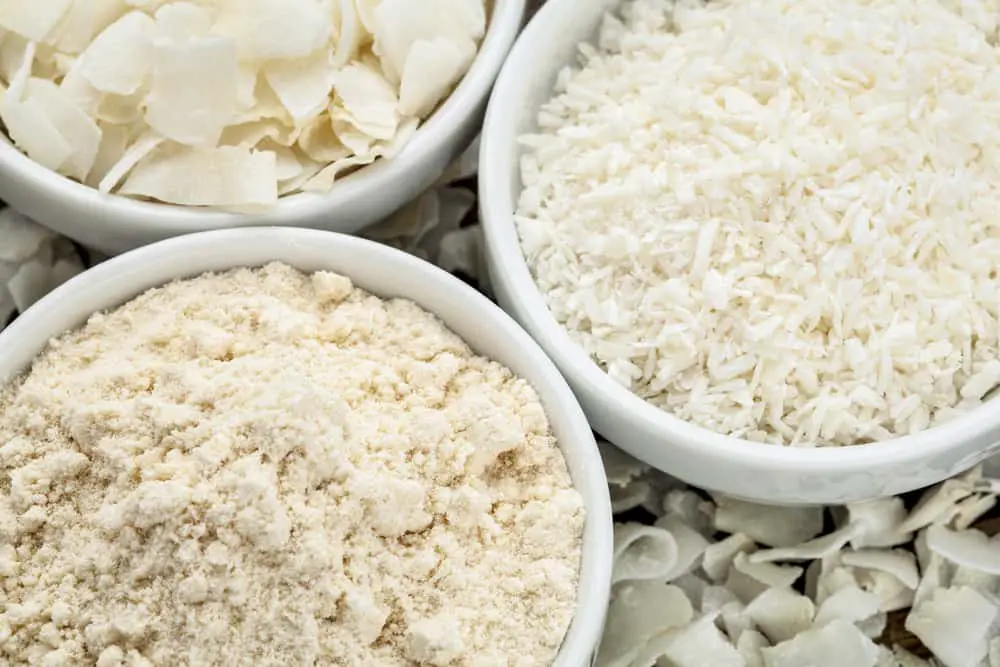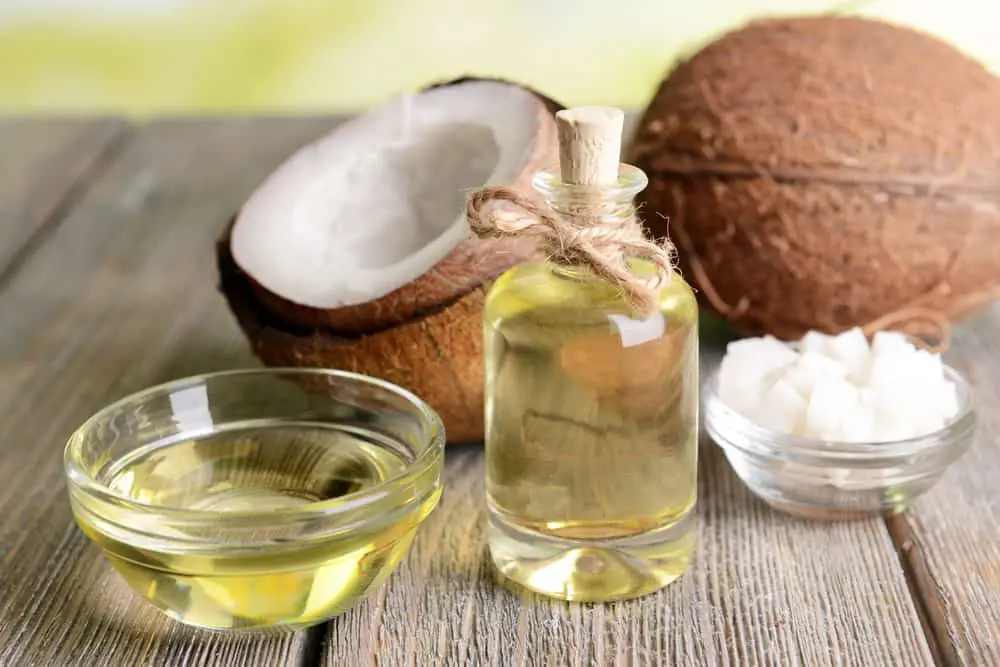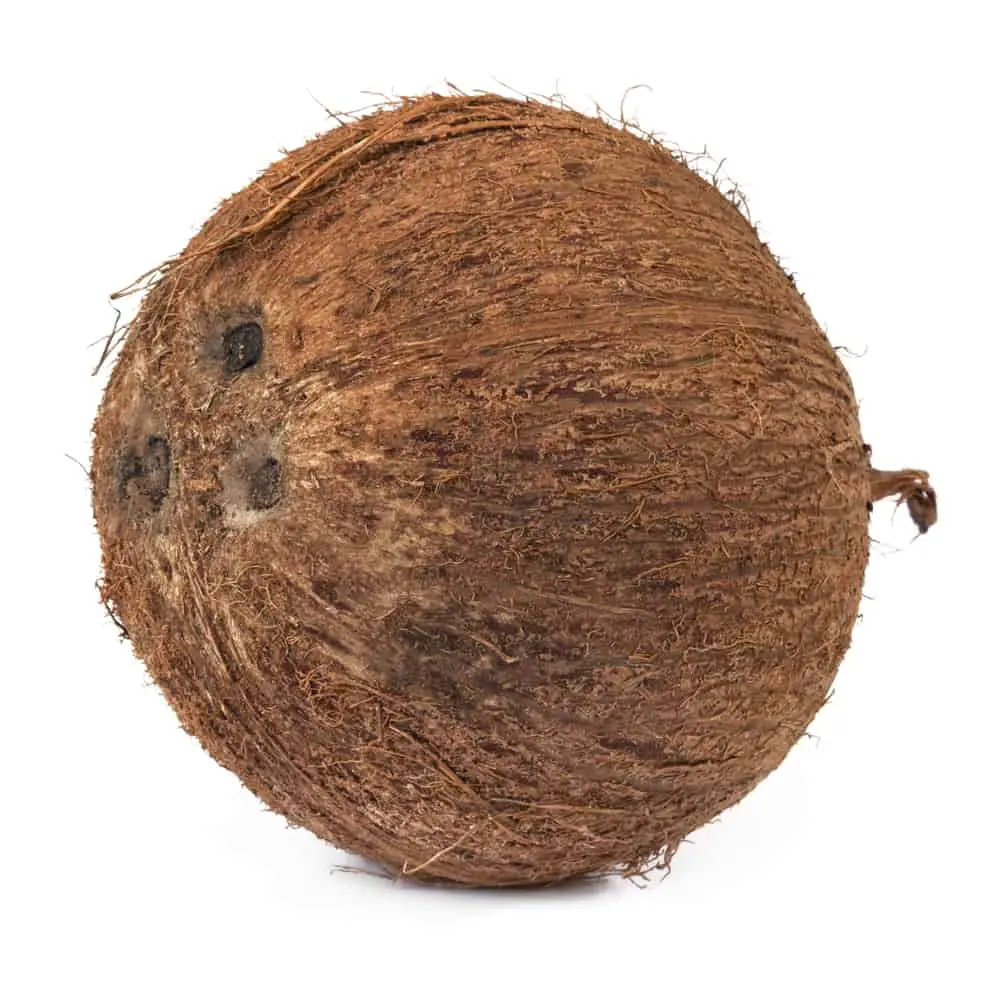Coconut is delish in and of itself, but when added to baking, the possibilities are limitless. You might not have considered this before, but there are a lot of different ways to enjoy coconut. Coconut products are a charismatic combination of flavor and nutrient density, and always make any dish they are added to delicious. With this in mind, what makes coconut a great ingredient for baking?
Coconut adds a robust flavor to almost any dessert that needs to be baked. You can apply coconut shavings to baked desserts or even bake coconut flesh all by itself for a crispy and nutty flavor that is delicious and even healthy.
The versatile coconut has long been held as a staple of desserts. But in this guide, we are going to explore what makes coconut such a great ingredient for baking. This luscious and refreshing fruit can be used in a variety of baked goods such as cookies, muffins, bread, cakes, granola bars, granola, and coconut macaroons. Read on to find out more about coconut in baking as well as essential information regarding its nutrition information.
Where Are Coconuts From?

Since coconut palms – the trees that produce coconuts – are tropical plants, coconuts can usually be found in coastal beach areas near the equator. To be specific, the tropical region extends 25 degrees north and south of the equator, so places within this zone will most likely have coconuts. This includes Thailand, the Philippines, Hawaii, Brazil, New Guinea, and many others.
The coconut palm, also known as Cocos nucifera, takes seven years after it has been planted, to produce any fruit. The seeds grow from the center of the tree, close to where the leaves protrude from the trunk. The trees produce seeds all year long, so at any given time a tree can house coconuts at any stage of development.
This varied rate of development can actually be a problem since palms are known to drop their wares randomly from about 30 feet in the air. Thankfully, many grocery stores are beginning to carry fresh coconuts in their produce section, so you don’t need to take a trip to a deserted tropical island to experience the joy of fresh coconut. Ask your local grocery to carry young Thai coconuts, which are known for their particularly tender flesh.
Fun fact: If you’re walking in an area where there are coconut trees, you must be careful not to get smashed in the head by falling seeds.
Coconut Basics
Coconuts probably originated somewhere in Indo-Malaya and are one of the most important crops of the tropics. Coconut flesh is high in fat and can be dried or eaten fresh or processed into coconut milk or coconut oil. The liquid of the nut, known as coconut water, is used in beverages.
A single coconut palm may yield 100 coconuts annually, and each fruit requires a year to fully ripen. Mature coconuts, ovoid or ellipsoid in shape, 300–450 mm (12–18 inches) in length and 150–200 mm (6–8 inches) in diameter, have a thick fibrous husk surrounding the familiar single-seeded nut of commerce.
A hard shell encloses the insignificant embryo with its abundant endosperm, composed of both meat and liquid. Coconut fruits float readily and have been dispersed widely by ocean currents and by humans throughout the tropics. Besides the edible kernels and the drink obtained from green nuts, the harvested coconut also yields copra, the dried extracted kernel, or meat, from which coconut oil, a major vegetable oil, is expressed.
The Philippines and Indonesia lead in copra production, and throughout the South Pacific copra is one of the most important export products. The meat may also be grated and mixed with water to make coconut milk, which is used in cooking and as a substitute for cow’s milk. The dry husk yields coir, a fiber highly resistant to saltwater and used in the manufacture of ropes, mats, baskets, brushes, and brooms.
The coconut palm is incredibly important as a foodstuff across the globe. Technically “dry drupes,” not true fruits, coconuts have a smooth outer shell (the exocarp), which is typically green or yellow, a fibrous husk (the mesocarp), and a hairy, brown shell (the endocarp) that surrounds the meat of the coconut as well as the coconut water contained inside.
In the United States, we commonly see only the brown, round endocarp sold in grocery stores, although tropical markets may sell the entire coconut.
The most common coconut products (aside from fresh coconuts) are:
- Dried coconut meat (copra) and desiccated coconut: Copra comes from dried white coconut meat. It’s high in oil and low in water content. Desiccated coconut is also made from coconut meat. It is dried and sieved into different grades of fineness. Desiccated coconut comes in sweetened and unsweetened versions, so be sure to consult your recipe before you purchase it.
- Coconut oil: Coconut oil comes in a couple of different varieties. Virgin (or extra virgin) coconut oil can be extracted from fresh coconuts, called “wet milling,” or expeller pressed from dried coconut meat. Most commercial coconut oil, which is frequently referred to as RBD (refined, bleached, deodorized) coconut oil, is made from copra, the dried meat of the coconut. Virgin coconut oil is solid at room temperature and white in color. Depending on how it is processed, it can have a mild to strong coconut flavor. Refined coconut oil is odorless and has a much higher smoke point than virgin oil. Here is a nice guide to selecting a good coconut oil.
- Coconut milk/cream: Coconut milk and cream are thick, sweet-ish liquids, typically made from shredded coconut meat. They are produced by pouring hot or boiling water over coconut meat, then squeezing the liquid out. (More water produces coconut milk, less water coconut cream.) You can easily make your own.
- Coconut sugar: Also called “palm sugar,” coconut sugar is made from the sap collected from the coconut palm tree flower bud.
- Coconut flour: Coconut flour is made by grinding dried, defatted coconut meat. It’s becoming more common as an alternative flour as the gluten-free movement catches fire.
- Coconut water: Coconut water is the naturally sweet, clear-ish liquid harvested from the inside of young, green coconuts. It can be found either shelf-stable or fresh in the refrigerated section of your grocery store.
How Did Coconuts Become So Popular?
Coconut cultivation, while not as damaging as palm oil production, does have some environmental tolls. Coconut farmers are often paid very little and exposed to dangerous pesticides. (Coconuts can also be quite dangerous to harvest.) A Stanford study done in 2010 found that coconut palms decrease soil nutrients, which may alter the feeding habits of animals and birds.
You can look for organic, fair trade coconut products to ameliorate some of these problems. Of course, if you are committed to local agriculture, consuming coconut products that typically come from the other side of the globe may not be the most sustainable option.
Like most tropical products, fresh coconuts are available year-round.
Coconuts are grown on farms across the tropics; Indonesia, the Philippines, India, Brazil, and Sri Lanka are the top global producers.
Coconuts are the product of the Cocos nucifera tree. Trees can be as large as 30 meters (about 100 feet) in height, but dwarf cultivars may be significantly shorter. There are over 80 varieties of the coconut palm, with different cultivars grown for different products — including coconut oil, coconut meat (copra), coconut water, and coconut coir (fiber).
The coconut palm is probably native to Southeast Asia, although there is some minor speculation that the tree may have tropical American origins. Recent genetic research, however, has unveiled two distinct areas of the origin of the tree’s cultivation — one in the Pacific basin and one in the Indian Ocean basin.
Pacific cultivars were probably first grown in the Philippines, Malaysia, and Indonesia, while Indian Ocean cultivars had their likely origins in Sri Lanka and the Maldives.
The cultivation origins of the coconut palm point to prehistoric trade routes and colonization. Ancient Austronesians likely brought coconuts with them on their trade routes to Indian Ocean sites that connected Southeast Asia to Madagascar and East Asia. In later times, Portuguese traders carried coconuts to West Africa, and finally to the Caribbean and South America. The first mainland US coconuts were grown in Florida in the 19th century.
Using Coconut in Baking

Coconut meat (and coconut water) are the most whole-food forms of coconut, as you can crack open a coconut and drain the water and scoop out the flesh. Truth be told, I don’t use coconut meat often. Here in Albuquerque, it’s easy to find inexpensive coconuts, but then you’ve got to breach the brown, fuzzy layers with mallets or hammers.
Considering I regularly walk into door frames and walls, slamming a hammer into a relatively small object in my hand seems like a poor idea!
It’s also possible to buy prepared coconut meat where all of the hammering and chiseling is already done for you. I’ve purchased coconut meat in this form occasionally, especially when I was following a raw food diet and many recipes called for it, but it can be expensive.
In addition to the immune-boosting and heart-healthy benefits (more on this below), coconut meat contains protein, and a range of minerals like iron, potassium, and magnesium, and is a source of fiber, which is great for the digestive tract.
When it comes to coconut baking, you can toss shredded coconut into a variety of baked goods (cookies, muffins, bread, cakes, granola bars, granola, coconut macaroons), sprinkle it on cereal, porridge, fruit, or yogurt, incorporate it into your fruit crumble topping, use it as grain-free breadcrumbs for tofu, fish or meat, or add it to your smoothies, ice cream or hot chocolate.
I also like to take large, wide-flaked coconut and make coconut chips.
What Kind Of Coconut Do You Use In Baking?
When coconut meat has been blended and strained for coconut milk, the pulp is dried into coconut flour. This gluten-free and grain-free flour is widely used in Paleo dishes and low-carb diets if you want a healthier coconut option in your baked goods.
Coconut flour is a concentrated source of fiber, almost double the amount of wheat bran. Also, since it’s grain-free, it’s suitable for a number of healing diets that eliminate the use of grains.
Coconut flour is wonderful in a variety of baked goods or as a flour for breading. Its high fiber content means you’ll have to use more liquid, as the coconut flour just soaks up liquid like crazy.
For every tablespoon of coconut flour, you add to a recipe, you’ll need to use an extra tablespoon of liquid as well.
Types Of Coconut in Baking
Coconut comes in a variety of different forms. Each of these types can be used in baking. Let’s take a closer look at each.
Fresh
If using a whole coconut, strip off the hairy bits, put the coconut into the oven at 355F for 15 mins to shrink the shell, then punch a hole in the soft ‘eyes’ and drain out the liquid. Using a heavy cleaver, carefully crack the coconut into pieces and price the flesh away from the skin with a small, sharp knife to remove the flesh.
To use the flesh for cooking, shred it with a coarse grater and store it in the fridge for 1-2 days.
Shredded
To make this light, fluffy, sweet product, coconut meat is boiled, grated, and then partially dried before being soaked in a liquid sugar solution and dried again. The soft, chewy texture helps give coconut macaroons their signature texture
Shaved
Since coconut is rich in natural sugar and oil, it makes a tasty snack when slices of it are baked or fried. Add them to trail mix or granola, or sprinkle them on a bowl of ice cream. Don’t be fooled into thinking coconut chips are a low-cal snack, though, as coconut is high in sugar and saturated fats (and some brands of coconut chips have even more sugar added).
Desiccated
Desiccated coconut is finely ground coconut, rather than bigger strips. This is also usually drier than shredded coconut. Unlike coconut flour, though, desiccated coconut maintains the fat content – so they can’t be used interchangeably.
Flaked
Unlike shredded or desiccated, flaked coconut is much larger. The coconut is shaved into long, wide flakes. Toast these flakes or use them as-is in all sorts of recipes for added flavor and texture.
To toast coconut at home, just pop the flakes in a dry skillet on top of the stove for about 5 minutes or spread across a sheet pan and toast in the oven at 350ºF for 6 to 8 minutes.
Sweetened vs. Unsweetened
The difference between sweetened and unsweetened coconut is pretty obvious: Unsweetened is plain coconut—no added ingredients—and sweetened coconut has added sugar.
Because of the added sugar, the sweetened coconut will be moister and sweeter. It works best in baking. Unsweetened coconut tends to be a bit drier and chewier. It can also be used in baking but works well in savory applications.
If your recipe doesn’t specify which kind of coconut you need, use your best judgment. Savory dish? Use unsweetened. Sweet bake? You can use whatever you have on hand. As for desiccated, flaked, or shredded, you can use your best judgment there, too. The larger the coconut pieces, the more texture you’ll have in your dishes. Whatever the case, you’ll end up with a tasty result
Coconut Nutrition
Even though coconut has healing capabilities, a lot of people are still not sure whether or not coconut oil is suitable for their health since it contains saturated fats. Pure coconut oil is extracted from ripe coconuts with hard flesh, while hydrogenated coconut oil is collected and then cold-pressed at 100-degrees Fahrenheit.
You are better off with unrefined and unprocessed virgin coconut oil. Hydrogenated coconut oil should not be mistaken for extra virgin coconut oil, as the two are entirely different.
If you are having trouble losing weight, then you should look into consuming coconuts. Even with saturated fat, it is not as dangerous as saturated fat soaked in high calories and cholesterol. Coconut contains a medium-chain fatty acid that not only aids in weight loss but boosts metabolism at the same time.
The fat burns off as energy rather than sticking to your belly. If that is not enough, it maintains a balance in your digestive tract and detoxifies your body.
Coconuts have no harmful by-products for you to worry about, even when it is heated to cook foods like other vegetable oils. The benefit of coconuts is that you can cook, bake and also make some of the most delicious vegan desserts with them.

By consuming water found in young coconuts, you will get all the electrolytes you will ever need. It is the highest-rated source of electrolytes, which is primarily responsible for keeping your body hydrated. It will also keep your nerves and muscles functioning optimally. To keep your skin healthy and young, you need not look further than coconut oil.
It contains antioxidants that slow down the aging process and protects your skin from harmful radiation from the sun. All you need to do is to apply a few drops of coconut oil to your skin. Use it before showering, so that it will be easier for the oil to be absorbed through your skin once your pores have opened up.
Coconuts contain lauric acid, which when digested forms a substance called monolaurin. These substances help fight against fungi, viruses, and bacteria to keep infections at bay. They’ve even been shown to help kill the bacteria Staphylococcus aureus and the yeast Candida albicans, a common source of yeast infections in humans.
The benefit of eating coconuts daily is that it supports the development of healthy teeth and bones. By doing so, you will improve your body’s ability to absorb manganese and calcium, which is vital for bone development and can also help prevent osteoporosis, a condition responsible for making bones fragile and thin while causing loss of density.
Coconuts are also an excellent alternative for people that are lactose intolerant.
The antifungal and antibacterial properties will protect the scalp from lice, dandruff, and itchy scalp, which are primarily responsible for reducing hair growth.
Consuming coconuts also:
- Boosts the immune system since coconuts are anti-parasite, antibacterial, antiviral, and antifungal.
- Provides quick energy and improves athletic and physical performance.
- Considerably reduces the risk of heart diseases.
- Protects against bladder infection and kidney disease.
- Restores and maintains thyroid functionality.
- Makes you look young by preventing age spots, sagging skin, and wrinkles.
Fortunately, there are a ton of recipes out there for ways you can cook various foods using coconut, so there is no way you will get bored with them. Once you stick to a coconut diet, there is no going back.
Is Coconut Safe For Peanut Allergies?
Botanically, coconuts are most closely related to other palms and betel nuts. They come from coconut palm trees and are not closely related to most other tree nuts.
While botanical relationships are not the only factor that determines whether two foods will be cross-reactive, foods that are close biological relatives often share related allergenic proteins. A good example of this phenomenon is cashews and pistachios. These are two closely related plants that contain similar proteins. People who are allergic to one of these nuts are often allergic to both.
There is some evidence of cross-reactivity between coconuts and hazelnuts and between coconuts and walnuts. One study also found an association between coconut allergies and those to almonds and macadamias.
While there are associations, the likelihood of also having a coconut allergy with a peanut allergy remains considerably low.
Baking With Coconut Oil

When it comes to baking, coconut oil makes a wonderful substitute for butter and other oils, like olive oil, canola oil, and vegetable oil. Regardless of the type of fat used in a recipe, you can swap in an equal amount of coconut oil.
Depending on the temperature at which it’s stored, coconut oil can be liquid or solid. In its solid state, coconut oil has a texture most similar to butter. When substituting butter with coconut oil, use solid, room-temperature coconut oil. This is especially important when using coconut oil to make pie crust — the chilled, solid oil should be cut into the flour just as you would with butter.
Baking With Coconut Extract
If you do not want to use real coconut, you can always use coconut extract instead. This product mimics the taste of fresh coconut.
How To Toast Coconut
When it comes to toasting coconut, the amount of time it takes for each method will vary slightly depending on your oven, microwave, or stove. You can use either sweetened shredded coconut or sweetened coconut flakes, both work great. I also suggest using about 1-2 cups of coconut, especially if you’re using the microwave or a skillet.
If you’re needing to make a larger batch of coconut, then I would stick with the oven method and use a large baking sheet. To toast coconut in the oven, preheat your oven to 350° (177°C). Spread the amount of coconut needed for your recipe into one even layer on a baking sheet.
Once the oven is preheated, place the baking sheet in the oven for 8-12 minutes. To toast coconut in the microwave, spread the coconut into an even layer in a small microwave-safe baking dish. I like to use an 8-inch square glass dish or a 9-inch pie plate to toast it this way. Then, place the baking dish in the microwave and microwave it in 30-second intervals.
After each interval, use a fork to stir the coconut around. Once the coconut starts to lightly brown, start microwaving it in 15-20 second increments to avoid burning it.
The amount of time the coconut takes will vary depending on your microwave. I have a 1200-watt microwave and mine usually takes about 8-10 30 second intervals or 4-5 minutes. Once the coconut is lightly browned, remove the baking dish from the microwave and set it on a wire rack to cool completely.
Can You Put A Fresh Coconut In The Oven?
You certainly can. The first way to prepare toasted coconut flakes is to make them in the oven. Baking your coconut in the oven typically allows you to make more toasted coconut at once since baking sheets tend to be larger than skillets. It’s also very hands-off and doesn’t require you to spend much time stirring or tending to the coconut while it’s cooking.
Here’s how to do it:
- Preheat the oven to 325°F.
- Line a large baking sheet with parchment paper. Spread the coconut evenly on the baking sheet, making sure the coconut is in a thin layer. Bake for about 5-10 minutes until the coconut begins to brown. Make sure you check on the coconut flakes or coconut shreds frequently, as they can start to toast quickly. You’ll also want to stir it after a few minutes. This will help prevent burning as well as encourage even toasting.
- Remove the baking sheet from the oven, and then remove coconut immediately from the baking sheet to allow it to cool completely.
Tips:
- Sweetened coconut takes less time in the oven, as the sugar speeds up the process.
- Use a large enough rimmed baking sheet to make sure your coconut doesn’t overlap.
- Check your coconut after 5 minutes to make sure it hasn’t started to get too crispy.
How To Toast Coconut In An Air Fryer
Spread the shredded coconut out on a plate. Take each slice of bread and first soak it in the coconut milk mixture and a few seconds before transferring it to the shredded coconut plate and fully coating the slice in the coconut. Space both the coated slices of bread in your air fryer, close it and set the temperature to 350°F and 4 minutes.
Take each slice of bread and first soak it in the coconut milk mixture and a few seconds before transferring it to the shredded coconut plate and fully coating the slice in the coconut. 4 Space both the coated slices of bread in your air fryer, close it, and set the temperature to 350°F and 4 minutes.
How To Toast Coconut In A Pan
Choose a frypan with a large surface area so you can spread the coconut out thinly.
Use medium-low heat so you can easily control the browning.
Constantly stir and shake the coconut to give it an even color.
Once golden, remove coconut from the pan and let cool. Do not leave it in the pan even with the heat turned off, as it will continue to toast and could burn.
Can You Toast Coconut In The Microwave?
Yes, coconut can be toasted in the oven. Choose a large microwave-safe plate and spread the coconut out as thinly as possible.
Microwave on high in one-minute intervals, tossing with a spoon every minute. Repeat for a total of 4-5 minutes.
Once the coconut has reached your desired color, remove it from the microwave and let cool.
How To Store Toasted Coconut
Once you’ve settled on your method and toasted up some delicious coconut flakes, it’s time to store it. The toasted coconut should be cooled completely before storing. Keep it in an airtight container or zip-top bag. It will keep at room temperature for up to a week or in the fridge for up to 1 month.
How Long Does Fresh Coconut Last?

How you store coconut is going to depend on which form you purchase. The high oil content makes coconut quickly turn rancid if not stored under the proper conditions.
Fresh unopened coconut can be stored at room temperature for up to four months, depending on its original freshness when purchased. The grated, fresh coconut should be put in a tightly sealed container or plastic bag. It can be stored in the refrigerator for up to four days or frozen for up to six months.
Unopened canned coconut can be stored at room temperature for up to 18 months. Packaged coconut in plastic bags can be stored for up to six months at room temperature. Once opened, both of these should be refrigerated and used quickly: five to seven days for canned and four weeks for dried coconut.
Can You Freeze Coconut?
If you decide to freeze coconut, make sure you sprinkle the coconut with sugar. If you sprinkle your coconut chunks with a light dusting of brown sugar, this helps to preserve them for slightly longer in the freezer. If you do this, however, be sure that it’s only a light dusting, as you don’t want to add too much sugar to the flesh.
Try shredding it. Instead of slicing your coconut into chunks, you can shred it. Instead of slicing the chunks, use a hand grater or food processor to shred the flesh of the coconut. You can then add it to a freezer-safe bag and place it in the freezer, just as above.
Don’t discard the liquid. The coconut liquid that you put to one side during the freezing process can be used in several ways. You can drink it as it is, add it to a smoothie, or even enjoy it with a scoop of coconut ice cream! Whatever you do, don’t let it go to waste.
You can freeze coconut for around six months.
Make sure you freeze your coconut as soon as you can after buying or picking it up. As you don’t necessarily know how fresh it is when you get it home, leaving it on the countertop for a few days might result in it going bad before you get the chance to freeze it.
Why Does My Coconut Taste Like Soap?
Unrefined coconut oil is rich in lauric acid which is one of the most common fatty acids used to make soap. So in fact, it’s more like soap tastes like coconut oil, not vice versa.
Like many so-called superfoods, the jury is out on how beneficial using coconut oil really is to one’s health but most armchair dieticians cite lauric acid as being the main wonder ingredient.
Why Is My Coconut Slimy?
Coconuts have three small dots on one end, these are the eyes of the coconut. Over time, mold will start to build up over the eyes and produce slime.
Cut coconuts can last a few hours out at room temperature. They can last up to a week in the refrigerator.
Shredded dried coconut can last up to six months if stored properly in the pantry. It can last up to eight months if stored properly in the fridge.
Toasted coconut can last up to a month in the pantry if stored properly in an airtight container.
Why Did My Coconut Turn Pink?
Pink coconut water is the result of the oxidation of the sugars in the coconut. When coconut sugars are exposed to oxygen, they turn pink. Temperature, age, sugar content, and how long the water has been exposed to air can all affect the coloration of coconut water.
It’s similar to how an apple turns brown after being cut and exposed to the air. Rest assured that, just as you can eat a brown apple, you can safely consume pink coconut water.
Why Did My Coconut Turn Yellow?
Most coconut water will have a slightly yellow color to it if you pour it into a glass. But if it is very yellow then it might be bad. Most coconut water will have a slightly yellow color to it if you pour it into a glass. Only if it is very yellow and smells bad do you need to worry.
So why are some coconuts yellow?
The coconut palm is highly susceptible to a disease known as lethal yellowing. Because of this, many homeowners and cities choose to grow Malayan cultivars such as “Malayan Dwarf,” which have better resistance to the disease. Unlike the species, “Malayan Dwarf” has leaves that are more yellow than green. This creates a yellow-ish coconut.
Coconut Fun Facts

Here are some fun coconut facts.
How To Open A Coconut
To open a coconut, Hold the coconut in your non-dominant hand.
Look for the imperfect “equator” line that runs around the middle of the coconut.
Take a hammer and whack along the equator line with swift hard hits—keeping the fingers of the hand holding the coconut well out of the way. Turn the coconut and continue whacking the equator line until the coconut splits open. You’ll probably end up turning the coconut all the way around three or four times.
Use your fingers to pull the two halves apart and place them cut side down on the counter.
You can use the blunt edge of a heavy butcher’s knife instead of a hammer, but be careful not to cut yourself.
Not all coconuts are created equal. They can be drier, fresher, bigger, or smaller. The method is the same, but some will open faster than others.
Is Coconut A Fruit?
Yes, coconuts are fruit.
Is Coconut A Tree Nut?
Yes, coconuts are classified as tree nuts. It doesn’t matter that coconuts are a fruit and not a nut.
Is Coconut A Seed?
A coconut is a fibrous one-seeded drupe, which is a fruit with a hard stony covering enclosing the seed. A seed is the reproductive unit of a flowering plant.
Do Coconuts Grow On Palm Trees?
Yes, coconuts exclusively grow on palm trees.
Can Dogs Have Coconut?

Coconut is non-toxic to dogs, but it does contain medium-chain triglycerides, which may cause some gastrointestinal upset and bloat.
Can Cats Eat Coconut?
Coconut is not toxic to cats, and experts agree it’s something they can occasionally snack on if they happen to like the taste of it. So you can safely offer your cat a little bit of coconut every so often
Our Choice For Best Frozen Coconut: Birdseye Frozen Coconut
Over the years, I have found that the frozen coconut by Birds Eye is one of the best types of frozen coconut. If you only bake seldomly, you may find that having frozen coconut is beneficial. This brand is incredibly moist and lasts for up to 6 months.
Where Can I Buy Birdseye Frozen Coconut?
Birdseye Frozen Coconut is sold at most major retailers.
